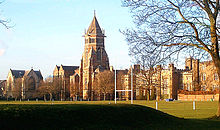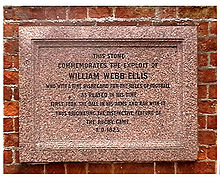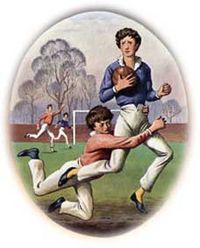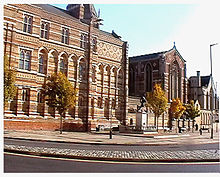- Rugby School
-
Rugby School Motto Orando Laborando
(Latin"By praying, by working")Established 1567 Type Independent school;
Co-educational
Day and boarding schoolReligion Anglican Headmaster Patrick S J Derham MA Founder Lawrence Sheriff Location Rugby
Warwickshire
EnglandStudents 831: 337 girls & 494 boys (2006) Gender Co-educational Ages 11–18 Houses 16 Colours Former Pupils Old Rugbeians Website www.rugbyschool.net Coordinates: 52°13′17″N 1°09′17″W / 52.2214°N 1.1548°W
Rugby School is a co-educational day and boarding school located in the town of Rugby, Warwickshire, England. It is one of the oldest independent schools in Britain.[1]
Contents
History
Rugby School was founded in 1567 as a provision in the will of Lawrence Sheriff, who had made his fortune supplying groceries to Queen Elizabeth I of England.[2] The influence of Rugby and its pupils and masters in the nineteenth century was enormous and in many ways the stereotype of the English public school is a reworking of Arnold's Rugby. It is one of the best known schools in the country and seen as an innovator in education (e.g. see its part in developing the Cambridge Pre-U).
Since Lawrence Sheriff lived in Rugby and the neighbouring Brownsover, the school was intended to be a free grammar school for the boys of those towns. Gradually, however, as Rugby's fame spread it was no longer desirable to have only local boys attending and the nature of the school shifted, and so a new school – Lawrence Sheriff Grammar School – was founded in 1878 to continue Lawrence Sheriff's original intentions; that school receives a substantial proportion of the endowment income from Lawrence Sheriff's estate every year.
Rugby School continues to offer scholarship places for outstanding students from the local community, who come from state (maintained) primary schools in the immediate vicinity of Rugby.[3] The school's new Arnold Foundation has been established to enable it to offer similar support to children from outside the Rugby area. The core of the school (which contains School House, featured in Tom Brown's Schooldays) was completed in 1815 and is built around the Old Quad (quadrangle), with its fine and graceful Georgian architecture. Especially notable rooms are the Upper Bench (an intimate space with a book-lined gallery), the Old Hall of School House, and the Old Big School (which makes up one side of the quadrangle, and was once the location for teaching all junior pupils). Thomas Hughes (like his fictional hero, Tom Brown) once carved his name onto the hands of the school clock, situated on a tower above the Old Quad. The polychromatic school chapel, new quadrangle, Temple Reading Room, Macready Theatre and Gymnasium were designed by the well-known Victorian Gothic revival architect William Butterfield in 1875, and the smaller Memorial Chapel was dedicated in 1922.
In 2005, Rugby School was one of fifty of the country's leading independent schools which were found guilty of running an illegal price-fixing cartel which had allowed them to drive up fees for thousands of parents.[4] Each school was required to pay a nominal penalty of £10,000 and all agreed to make ex-gratia payments totalling three million pounds into a trust designed to benefit pupils who attended the schools during the period in respect of which fee information was shared.[5] However, Mrs Jean Scott, the head of the Independent Schools Council, said that independent schools had always been exempt from anti-cartel rules applied to business, were following a long-established procedure in sharing the information with each other, and that they were unaware of the change to the law (on which they had not been consulted). She wrote to John Vickers, the OFT director-general, saying, "They are not a group of businessmen meeting behind closed doors to fix the price of their products to the disadvantage of the consumer. They are schools that have quite openly continued to follow a long-established practice because they were unaware that the law had changed."[6]
Headmasters
- Richard Seele - 1600
- Nicolas Greenhill - 1602
- Augustus Rolfe - 1606
- Wiligent Greene - to 1642
- Raphael Pearce - 1642 to 1651
- Peter Whitehead
- John Allen - to 1669
- Knightley Harrison - 1669 to 1674
- Robert Aahbridge - 1674 to 1681
- Leonard Jeacocks - 1681 to 1687
- Henry Holyoake - 1687 to 1730
- John Plomer - 1731 to 1742
- Thomas Crossfield - 1742 to 1744
- William Knail - 1744 to 1751
- John Richmond - 1751 to 1755
- Stanley Burrough - 1755 to 1778
- Thomas James - 1778 to 1794
- Henry Ingles - 1794 to 1806
- John Wooll - 1806 to 1827
- Thomas Arnold - 1828 to 1842
- Archibald Campbell Tait - 1842 to 1848
- Dr Edward Meyrick Goulburn - 1849 to 1857
- Frederick Temple - 1858 to 1869
- Henry Hayman DD - 1870 to 1874
- Thomas William Jex-Blake, DD, 1874 to 1887
- John Percival, DD, - 1887 to 1895
- Herbert Armitage James, DD - 1895 to 1910 [7]
- Albert Augustus David - 1910 to 1921[7]
- William Wyamar Vaughan - 1921 to 1931[7]
- Percy Hugh Beverley Lyon - 1931 to 1948[7]
- Sir Arthur Frederic Brownlow fforde - 1948 to 1957[7]
- Walter Hamilton - 1957 to 1966[7]
- James Woodhouse - 1967 to 1980
- Brian Rees -1980 to 1985[8]
- Richard Bull - 1985 to 1990[8]
- Michael Mavor - 1990 to 2001[8]
- Patrick Derham - 2001 to present
Thomas Arnold
The school's most notable headmaster was Thomas Arnold. Appointed in 1828 he executed many reforms to the school curriculum and administration and was immortalised in Thomas Hughes' book Tom Brown's School Days. However, it is wrong to associate Arnold too closely with the image of him presented in that book. In his authoritative 'Godliness and Good Learning' (Cassell 1961), D.H. Newsome points out that muscular Christianity developed after Arnold's time at Rugby and that "although 'Tom Brown's School Days' is one of the earliest examples of the delight in athleticism, the ideal there expressed is not that of Arnold but of Thomas Hughes [the author]" (page 80).
John Percival
In 1888 the appointment of Marie Bethell Beauclerc by Percival was the first appointment of a female teacher in an English boys' public school and the first time shorthand had been taught in any such school. The shorthand course was popular with one hundred boys in the classes.
William Webb Ellis
The game of Rugby owes its name to the school. The legend of William Webb Ellis and the origin of the game is commemorated by a plaque. The story has been known to be a myth since it was first investigated by the Old Rugbeian Society (renamed the Rugbeian Society) in 1895. There were no standard rules for football during Webb Ellis's time at Rugby (1816–1825) and most varieties involved carrying the ball. The games played at Rugby were organised by the pupils and not the masters, the rules of the game played at Rugby and elsewhere were a matter of custom and were not written down. They were frequently changed and modified with each new intake of students. The sole source of the story is credited to one Matthew Bloxam (a former pupil, but not a contemporary of Webb Ellis) in October 1876 (four years after the death of Webb Ellis) in a letter to the school newspaper (The Meteor) wherein he quotes some unknown friend relating the story to him. He elaborated on the story some three years later in another letter to The Meteor, but shed no further light on its source. Richard Lindon is credited for the invention of the "oval" rugby ball, the rubber inflatable bladder and the brass hand pump.[9] Lindon, a Boot and Shoemaker, had premises immediately across the street from the School's main entrance in Lawrence Sheriff Street. No doubt the boys of Rugby School had significant input into their required design.
It is also fair to say that cross country running may have begun at Rugby School. The Big-Side Runs were one of the first such events of their type in public schools and were started in 1837. The Crick Run was started in 1838 and is still a major annual event in the School's calendar.
Houses
Rugby School has both day and boarding-pupils, the latter in the majority. Originally it was for boys only, but girls have been admitted to the sixth form since 1975. It went fully co-educational in 1995.
The school community is divided into houses:
Boys:
- Cotton House
- Kilbracken
- Michell House
- School Field
- School House
- Sheriff House
- Town House (Day House)
- Whitelaw House
Girls:
- Bradley House (ex boys' house)
- Dean House
- Griffin House
- Rupert Brooke House
- Southfield House (Day House)
- Stanley House (ex boys' house: 6th form)
- Tudor House (ex boys' house)
Junior School:
- Marshall House (Day House. Pupils leave Marshall House at age 13 to join one of the other houses, usually Town for boys and Southfield for girls)
Information
- Age range: 11 - 18
- Day pupils: 77 boys, 64 girls
- Annual day fees: £17,475 - £22,815; Juniors £10,299 (numerous scholarships and bursaries available)
- Full boarding pupils: 369 boys, 296 girls
- Annual full boarding fees: £28,050
- Total pupils: 446 boys, 360 girls
- Including 6th form/FE: 194 boys, 168 girls
- Staff numbers: 100 full time - 9 part time
- Method of entry: Common Entrance, Interview, Scholarship or bursary exam
- Professional affiliations: HMC
- Religious affiliation: Church of England[10]
Alumni
Main article: Alumni of Rugby SchoolThere have been a number of notable Old Rugbeians including the purported father of the sport of Rugby William Webb Ellis, the inventor of Australian rules football Tom Wills, the war poets Rupert Brooke and John Gillespie Magee, Jr., Prime Minister Neville Chamberlain, author and mathematician Lewis Carroll, poet and cultural critic Matthew Arnold, the author and social critic Salman Rushdie (who said of his time there: "Almost the only thing I am proud of about going to Rugby school was that Lewis Carroll went there too."[11]) and the Irish writer and republican Francis Stuart. Matthew Arnold's father Thomas Arnold, was a headmaster of the school. An OR seven-a-side rugby team was invited to compete in the inaugural Old Boys Sevens tournament in June 2010, hosted by the Old Silhillians, the former pupils' association of Solihull School.
Rugbeian Society
The Rugbeian Society is for former pupils at the School.[12] An Old Rugbeian is sometimes referred to as an OR.
The purposes of the society are to encourage and help Rugbeians in interacting with each other and to strengthen the ties between ORs and the school.
in 2010 the Rugbeians reached the Semi Finals of the Public Schools' Old Boys' Sevens tournament, hosted by the Old Silhillians to celebrate the 450th anniversary of fellow Warwickshire public school, Solihull School.
Rugby Fives
Rugby Fives is a handball game, similar to squash, played in an enclosed court. It has similarities with Winchester Fives (a form of Wessex Fives) and Eton Fives.
It is most commonly believed to be derived from Wessex Fives, a game played by Thomas Arnold, Headmaster of Rugby, who had played Wessex Fives when a boy at Lord Weymouth's Grammer, now Warminster School. The open court of Wessex Fives, built in 1787, is still in existence at Warminster School although it has fallen out of regular use.
Rugby Fives is played between two players (singles) or between two teams of two players each (doubles), the aim being to hit the ball above a 'bar' across the front wall in such a way that the opposition cannot return it before a second bounce. The ball is slightly larger than a golf ball, leather-coated and hard. Players wear leather padded gloves on both hands, with which they hit the ball.
Rugby Fives continues to have a good following with tournaments being run nationwide, presided over by the Rugby Fives Association.[13]
School slang
In common with most English public schools, Rugby has its own argot, a few words of which are listed below. Also, the Oxford "-er" abbreviation (e.g. Johnners, rugger, footer etc.), prevalent at Oxford University from about 1875, is thought to have been borrowed from the slang of Rugby School.[14] However, much of the slang below is now obsolete as marked.
- Bags: Sporting colours (particularly 'The Holder of Bigside Bags', the Captain of the Running Eight)
- Beaks: Teachers (obsolete: current pre-1970)
- Bodger: The current headmaster (After Dr. H. A. James - former headmaster (1895–1909). He gained this nickname while headmaster at Rossall School.) (obsolete - current in 1970s and earlier)
- Boomer: Chapel Bell (not actually functional, on the premise the tower may collapse)
- Bosh: A traditional game of soccer between School House and School Field on the Close annually
- Bug: Library (obsolete: current pre-1970). The main library is the Temple Reading Room (TRR)
- Close: Rugby and cricket pitches outside School House. Also serves as a form of punishment in School House, where the offender walks around the Close early in the morning.
- Cock House: winner of the inter house rugby competition
- Copy: Award for exceptional work
- Credit: Award that is just below a distinction
- Crick Run: annual long distance run from Crick to Rugby
- Defaulter : half an hour of manual labour, that could be imposed as a punishment by a sixth
- Dics: House prayers or talks on useful information (obsolete - current in 1960s and earlier)
- Distinction: Award for slightly less exceptional work than a Copy
- D-Block: Year 11
- E-Block: Year 10
- F-Block: Year 9
- Far Polo: the most distant rugby pitches, only occasionally used, located on farmland more usually used for grazing sheep.
- Gation: Second to worst form of punishment in the form of boarding house arrest with staff or Levee signatures required on the hour.
- Ground Work: 2 hours of manual labour, imposed as a punishment
- G-Block: Years 7 and 8
- Imposition: Lowest form of punishment
- Job: 1 hour of manual labour, imposed as a punishment
- Lacque (pronounced 'Lake'): Room for the sixth in Sheriff House
- Levee: School prefect
- LXX: (Known as Lower Twenty) Year 12
- Hall: The table below that of the Sixth. Members of Hall have or had certain privileges, such as that of carrying an umbrella, or making toast (obsolete: current pre-1970 )
- The Marshall: A figure who makes sure everything is as it should be
- New Turf and Old Turf: Hockey Astro Pitches
- New Quad and Old Quad: The two areas around OBS
- Old Guard: Sports team of teachers
- OBS: Old Big School
- OR: Old Rugbeian
- Pig Hut run: Physical punishment of running to Levee hut (obsolete)
- Pontines: 2nd XV rugby pitch
- The Porridge: The gravel area outside the Chapel
- Rustication: Highest form of punishment before expulsion. Sent home or occasionally sent to live with Chaplain.
- Sixth: House prefect
- Speckle: To sack someone from being a House Sixth (the Sixth tie is speckled)
- Stewboi: A hindrance - 'To lay a Stewboi' being the correct term for hindering a pupil - or a fashion of hat worn
- Stodge: School tuck shop
- Stripe: To sack someone from being a Levee (the Levee tie is striped)
- Tanner: Day-boy (from 'Town House') (obsolete)
- Tick: The obligatory salutation of a Beak in the street, by lifting an index finger to shoulder level (obsolete - current in 1960s and earlier)
- Topos: Lavatory (from Greek τόπος, meaning 'a place') (obsolete - current in 1980s and earlier)
- Tosh: The old 662⁄3 yard open-air swimming pool, also used as a skating rink in winter, demolished by the School Governors in 1989 and replaced with a basket-ball court and a smaller indoor swimming pool. In some houses a name given to a large communal shower room. Also, a bath (sb.) or to take a bath
- Wagger: Waste paper basket (abbreviation of "wagger pagger bagger" - see Oxford "-er") (obsolete - current in 1960s and earlier)
- XX: Year 13
School song
"Floreat Rugbeia" is the traditional school song. While a boy's house, Tudor house had an alternate first verse of the Floreat which for more than two centuries by tradition they would sing by heart at Chapel contrary to all other houses of the school which would sing the official first verse of the Floreat.[citation needed] Members of Tudor House would then continue to sing the correct second and third verse of the Floreat which Older boys ensured that younger boys knew by heart. No other house memorised either versions of the Floreat. The girls now residing in Tudor house have not continued the boys' original tradition, other than on reunion days for the Old Rugbeians.
See also
- List of schools in the West Midlands
- Four Rugby Boys
References
- ^ List of Schools on Emetis.com
- ^ "Rugby" by Henry Christopher Bradby
- ^ "Scholarships" Rugby School web site
- ^ Independent schools face huge fines over cartel to fix fees
- ^ Article at UK Office of Fair Trade
- ^ "Private schools send papers to fee-fixing inquiry". The Daily Telegraph (London). 1 March 2004. http://www.telegraph.co.uk/news/1455730/Private-schools-send-papers-to-fee-fixing-inquiry.html. Retrieved 15 March 2011.
- ^ a b c d e f John Barclay Hope Simpson, Rugby Since Arnold: A History of Rugby School from 1842, Published by Macmillan, 1967
- ^ a b c Rugby School - History and Traditions
- ^ Richard Lindon web site
- ^ Good Schools Guide
- '^ Salman Rushdie: 'The Arab spring is a demand for desires and rights that are common to all human beings, Telegraph
- ^ Rugbeians On-line
- ^ Ruby Fives Association
- ^ "A Dictionary of Slang and Unconventional English., Partridge, Eric, Routledge & Kegan Paul, London 1984. p. 1390
External links
- Rugby School official website
- The Rugbeian Society website
- Profile at the Good Schools Guide
Schools in Warwickshire Primary Comprehensive Alcester High School · Ash Green School · Ashlawn School · Avon Valley School · Aylesford School · Bilton School · Campion School · Etone Community School and Technology College · Harris School · Higham Lane School · Kenilworth School and Sports College · Kineton High School · Kingsbury School · Myton School · Nicholas Chamberlaine Technology College · North Leamington School · The Polesworth School · Shipston High School · Stratford-upon-Avon High School · St Thomas More Catholic School and Technology College · Trinity Catholic SchoolSixth Form Colleges Further Education Colleges Grammar Independent Arnold Lodge School · Bilton Grange · The King's High School For Girls · Kingsley School · Princethorpe College · Rugby School · Warwick SchoolSpecial Former Categories:- Boarding schools in Warwickshire
- Member schools of the Headmasters' and Headmistresses' Conference
- Old Rugbeians
- Racquets venues
- Independent schools in Warwickshire
- Schools with Combined Cadet Forces
- Educational institutions established in the 1560s
- 1567 establishments in England
- Rugby, Warwickshire
- IRB Hall of Fame inductees
Wikimedia Foundation. 2010.






